25 Sales Metrics High-Performing Sales Teams Are Tracking
Casey O'Connor
There’s nothing but truth to the old saying, “What gets measured gets managed.”
Keeping track of sales metrics and overall sales performance has never been more important than it is today. The rise of digital sales tools has afforded salespeople virtually unlimited access to just about any data they seek.
In fact, there’s so much data available that many sales teams struggle to know which sales metrics to track, and how to use them to drive performance.
In this article, we’ll go over everything you need to know about sales metrics, including why they’re so important, which to track (no matter what type of business you run), and tools you can use to help the process.
Here’s what we’ll cover:
- What Are Sales Metrics?
- Why Tracking Sales Metrics Is Important
- 25 Sales Metrics to Track
- Sales Activity Metrics
- Leading vs. Lagging Indicators
- Challenges in Tracking Sales Metrics
- Sales Tracking Tools
What Are Sales Metrics?
Sales metrics are specific data points that measure the sales performance of an individual sales rep, a sales team, or an entire organization over a set period of time.
Salespeople have always used sales metrics to track their performance and guide their strategy. Insight from sales metrics helps teams identify which parts of the sales process are working well, and which need attention.
Sales metrics also help sales teams:
- Monitor their progress on reaching sales goals
- Prepare and plan for scaling and growth by contributing to accurate sales forecasts
- Determine compensation plans, commission rates, incentives, and rewards
In other words, sales metrics analytics help sales teams make data-backed decisions to optimize the strategies and tactics that improve their results.
Why Tracking Sales Metrics Is Important for Sales & Marketing
Tracking sales metrics is clearly important for sales performance, but it also has implications for the marketing department.
Sales metrics act as a lagging indicator for marketing initiatives. We’ll talk more about leading vs. lagging indicators later in this article.
In simple terms, sales metrics help marketers determine how effectively their marketing strategies resonate with their target audience. Salespeople and marketers can use sales metrics to help them reverse-engineer their strategies and tactics in a way that improves results.
Sales metrics help marketing and sales teams create a scalable, repeatable process for success in both departments.
Important Sales Metrics to Track
While it’s true that tracking sales metrics is universally important to each and every company that wants to be successful, there’s more room for debate when it comes to which specific metrics are most important.
The truth is, the best sales metrics to track will vary by sales team, company, and performance goals.
What’s important for an enterprise company will probably not even be on the radar of a startup; similarly, SaaS companies need to consider different sales metrics than companies that sell one-and-done products.
That being said, there are several key sales metrics to track that will likely provide valuable insight to just about any company who wants to make data-based decisions on their marketing and sales strategies.
1. Revenue
One of the most relevant sales metrics for any company to track is revenue.
Tracking revenue can provide salespeople with an incredible amount of insight into their performance. That’s partially because it speaks directly to the bottom line — which is obviously very important to monitor in order to be successful.
Here’s the formula to calculate total revenue: 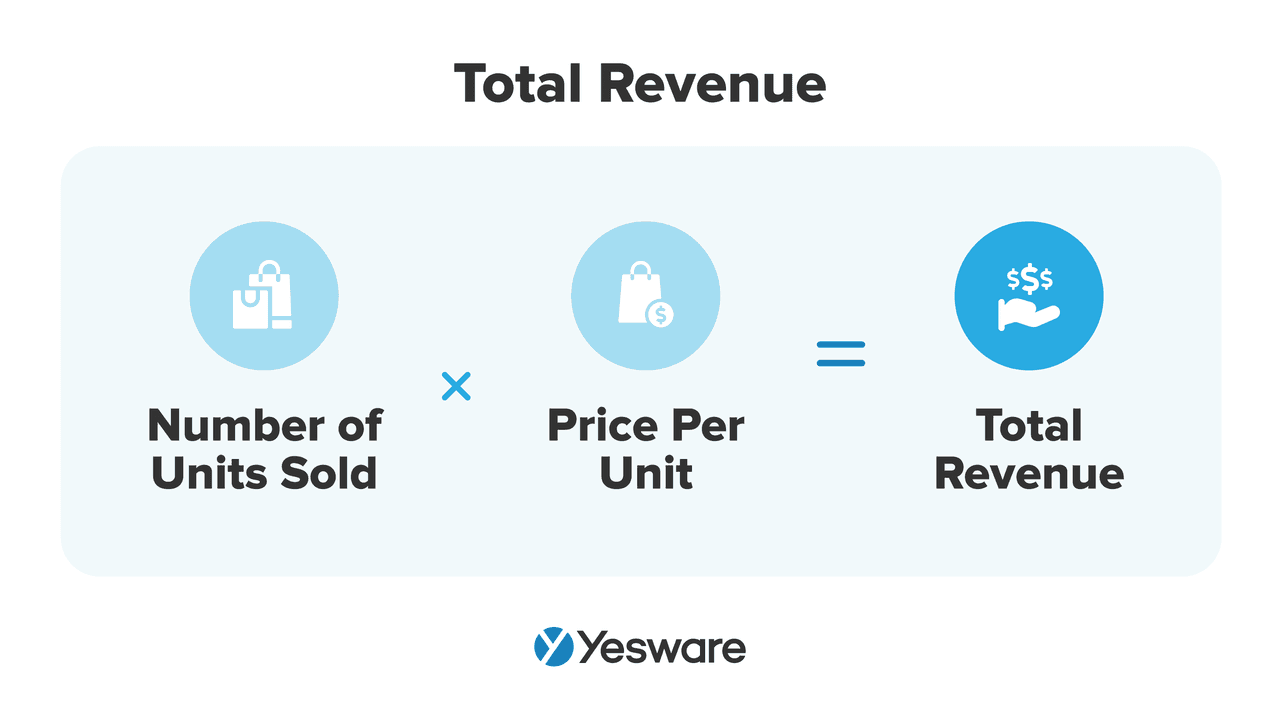 Tracking revenue is powerful for another reason: it’s an extremely flexible metric that can be measured in a variety of ways.
Tracking revenue is powerful for another reason: it’s an extremely flexible metric that can be measured in a variety of ways.
Teams can analyze a subset of the revenue metric — like the amount of revenue generated by individual sales reps — to determine how effectively each member of the team works.
They can also track revenue by product, revenue by territory, or average revenue per user account to determine which of their segments is most profitable.
Teams might track what percentage of revenue is generated by new business vs. existing business. SaaS teams may analyze annual recurring revenue (ARR). Tracking revenue can also help teams determine their year-over-year growth rate.
Tracking each of these sub-metrics born out of revenue helps sales and marketing teams create accurate forecasts and strategically plan for growth.
2. Average Customer Lifetime Value (LTV)
Average customer LTV represents the average total revenue that a customer generates throughout its contract with your business.
Here’s the formula to calculate customer LTV: 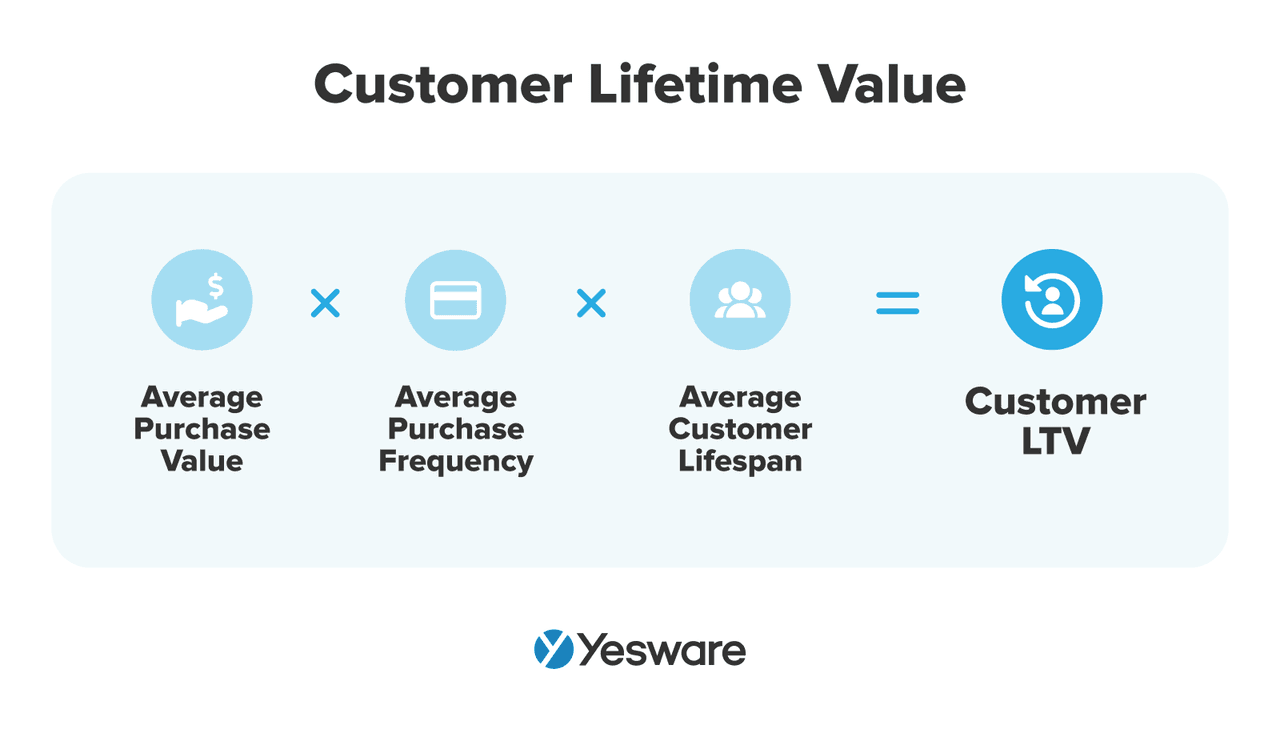 This metric is useful in determining which customer segments are most lucrative to your business.
This metric is useful in determining which customer segments are most lucrative to your business.
3. Market Penetration Rate
The market penetration rate is sometimes overlooked in favor of the “bigger” metrics like revenue, but it can be extremely insightful for determining your team’s current sales effectiveness, as well as your opportunities for growth.
Market penetration rate refers to how much of the total addressable market your company currently serves.
Here’s the formula to calculate market penetration rate:  If your market penetration rate is currently low, don’t despair — that means there are plenty of opportunities to expand your reach. A low market penetration rate might indicate a need to revisit your ideal customer profile (ICP) and/or your specific sales strategies.
If your market penetration rate is currently low, don’t despair — that means there are plenty of opportunities to expand your reach. A low market penetration rate might indicate a need to revisit your ideal customer profile (ICP) and/or your specific sales strategies.
4. Quota Attainment
This sales metric is likely familiar to most sales professionals.
Sales quota attainment measures how close a sales rep or sales team comes to meeting their sales goals. It is usually measured per month, per quarter, or per year.
Here’s the formula to calculate quota attainment: 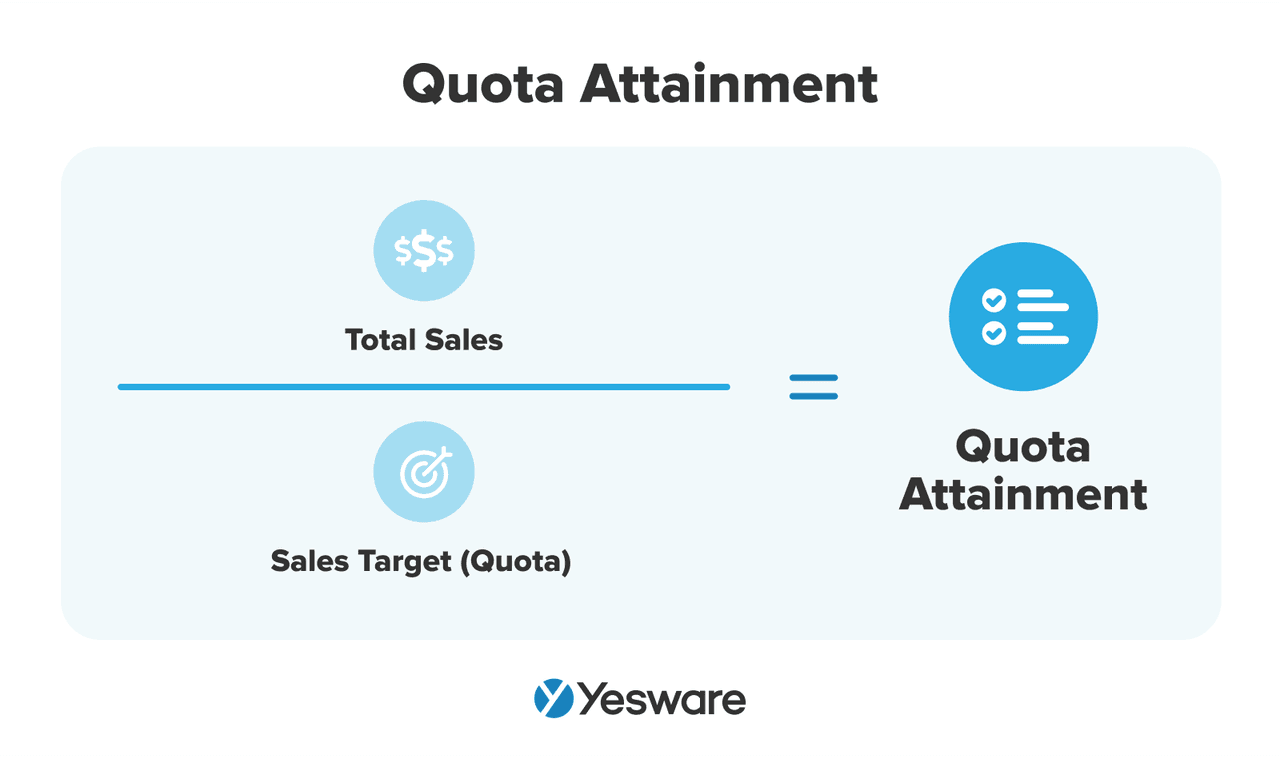 Quota attainment analysis helps sales managers adjust sales forecasts as needed, identify both top-performing sales reps and those that need coaching, and optimize their sales strategies.
Quota attainment analysis helps sales managers adjust sales forecasts as needed, identify both top-performing sales reps and those that need coaching, and optimize their sales strategies.
5. Win Rate
Win rate is another straightforward sales metric that can go a long way in evaluating sales performance.
Your win rate measures the percentage of sales opportunities that become closed-won deals.
Here’s the formula to calculate opportunity win rate: 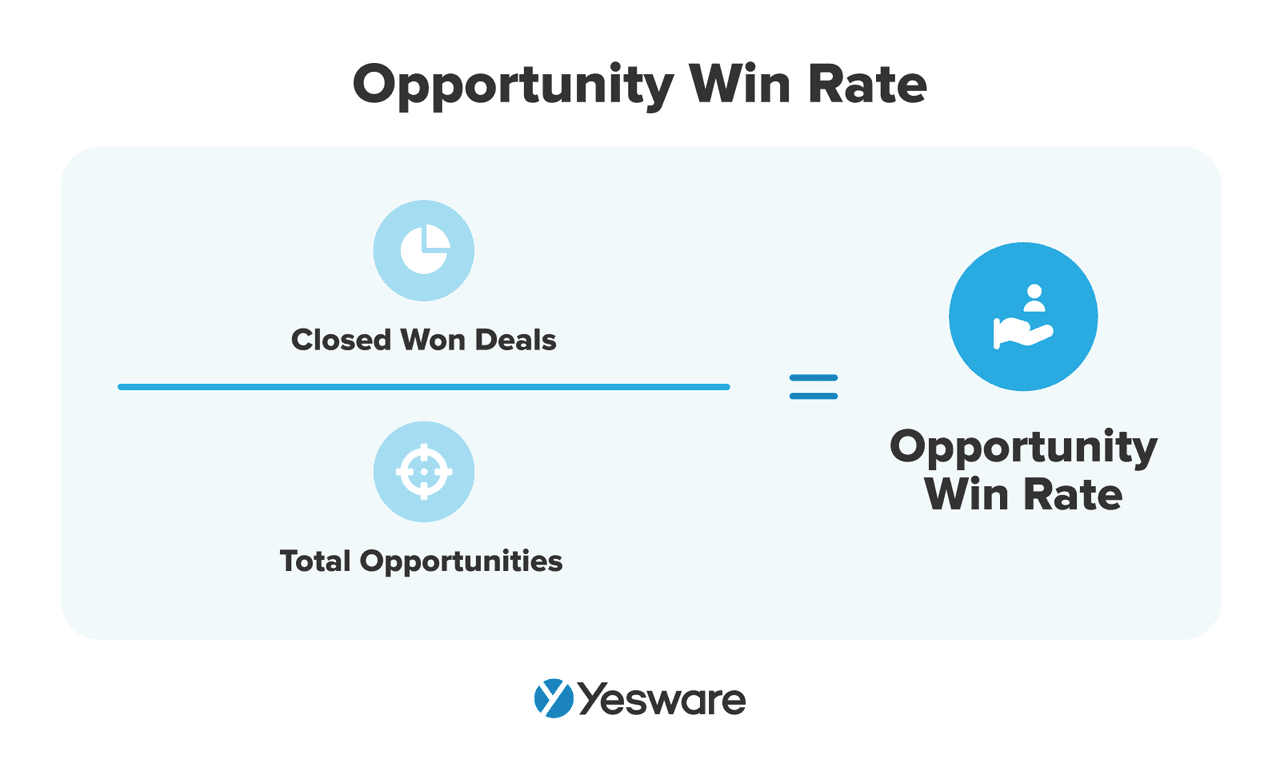 This metric is slightly different than conversion rate, as it only measures how many conversions took place once a lead was deemed a true opportunity.
This metric is slightly different than conversion rate, as it only measures how many conversions took place once a lead was deemed a true opportunity.
In other words, this metric helps sales professionals determine how effectively they make their pitch.
Win rate can be calculated based on individual sales reps or by the team as a whole. It can help sales managers determine how many additional deals will be needed to meet specific sales targets.
6. Sales Cycle Length
Sales cycle length refers to the average amount of time it takes for an unqualified lead to become a customer.
This is a popular sales metric, and for good reason — the most profitable sales processes are the ones that don’t take a minute longer than they need to.
Here’s the formula to calculate average sales cycle length: 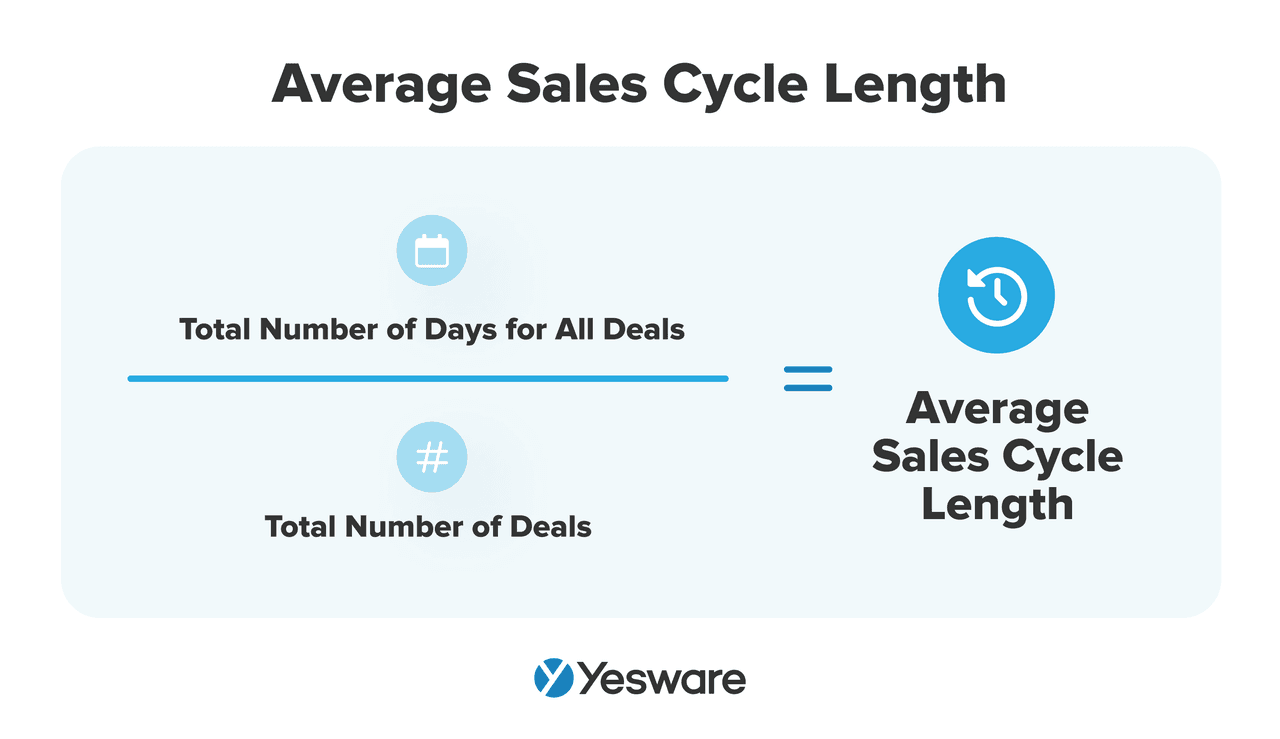 Keep in mind that this sales metric will mean different things to different companies.
Keep in mind that this sales metric will mean different things to different companies.
Although it appears at surface level that the shortest sales cycles are the most profitable ones, shorter does not always equal better.
Many sales teams that sell to enterprise companies, for example, can testify that the need for several decision-makers and consideration slows their sales process — but that’s not necessarily “bad.”
Instead of thinking about how to simply shorten the sales cycle, consider how your team can optimize it.
7. Deal Slip Rate
A team’s deal slip rate represents the percentage of sales opportunities that don’t close within the forecasted sales cycle.
This sales metric can shed a lot of insight into deals that are lost to the competition, or about which parts of the sales pipeline see the most leakage.
Deal slippage is an important factor in creating accurate sales forecasts, as well as strategizing ways to present your product’s USP in ways that elevate you from the competition.
8. Cost of Selling
Many sales metrics pay close attention to the number of deals and amount of money coming in, but some teams neglect to look at the other side of the balance sheet.
It’s critically important that sales teams consider how much money they (and marketing) spend to make sales. Revenue sales metrics mean very little unless compared against the expense it required to generate it.
9. Sales by Lead Source
Determining how many of your sales come from each lead source (e.g., web traffic, LinkedIn or social media, lead magnet, etc.) is an important sales metric for optimizing sales strategy.
Not only will this sales metric help you prioritize your hottest segment of leads, it will also help your team strategize ways to more effectively reach the lagging segments.
10. Pipeline Coverage
Pipeline coverage refers to the value of a sales rep’s or sales team’s potential sales opportunities as it compares to their quota within a specific time frame. This sales metric is expressed as a multiple of the quota.
Here’s the formula to calculate pipeline coverage: 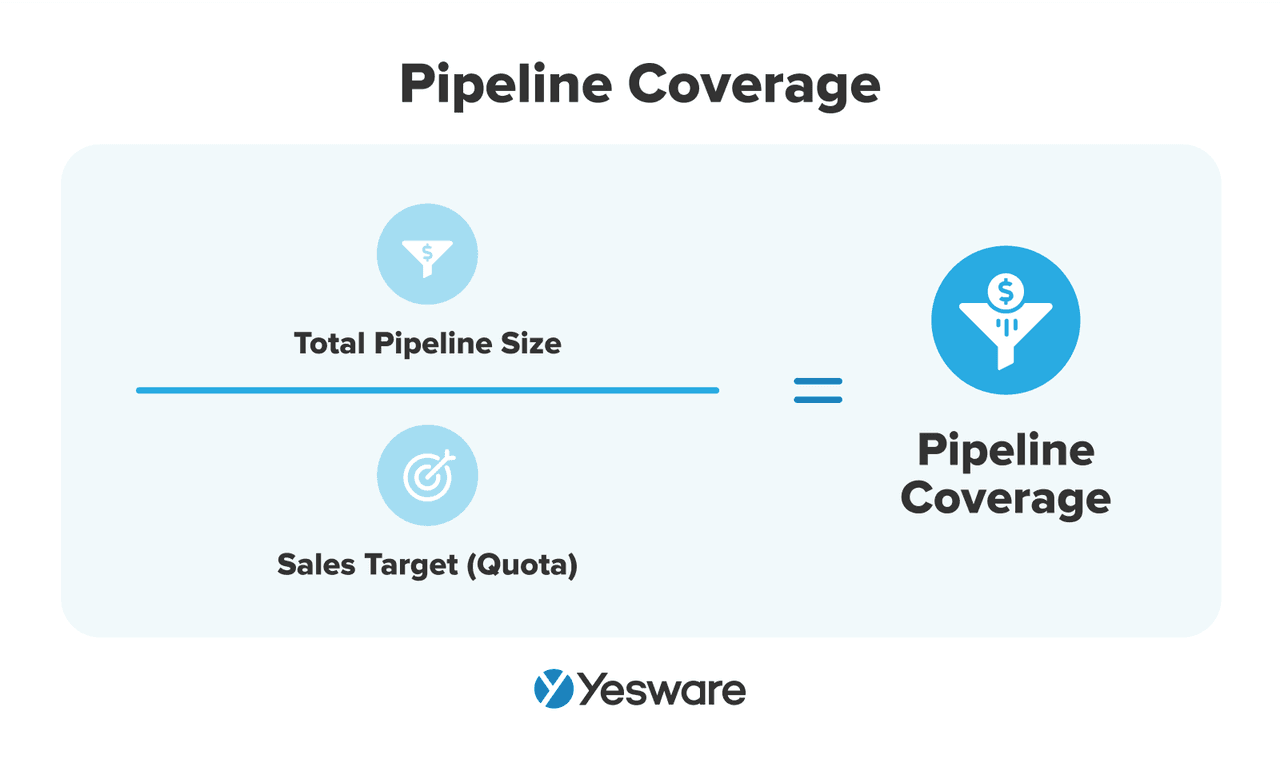 Pipeline coverage analysis helps sales professionals adjust their approach as they work so that they come closer to meeting their quota.
Pipeline coverage analysis helps sales professionals adjust their approach as they work so that they come closer to meeting their quota.
11. Annual Contract Value
The annual contract value (ACV) is the average revenue generated per contract, per year.
Here’s the formula to calculate ACV:  ACV is a particularly important metric for SaaS companies, or other organizations that offer yearly or multi-year contracts.
ACV is a particularly important metric for SaaS companies, or other organizations that offer yearly or multi-year contracts.
Make sure everyone on your team is clear about how exactly your organization calculates annual contract value. Some teams, for example, exclude one-time fees from their revenue calculations, while others consider those included.
However your team defines the “Total Contract Value” is up to you, but it’s important that everyone is on the same page about how it’s measured.
12. Conversion Rate by Sales Funnel Stage
Savvy sales teams know that they need to look at their performance at each individual stage of the sales funnel.
In other words, how effectively does your team nurture leads at each stage?
Calculating the conversion rate by stage can help teams identify bottlenecks and particular issues with content at a specific stage of the process.
Here’s the formula to calculate conversion rate by sales funnel stage: 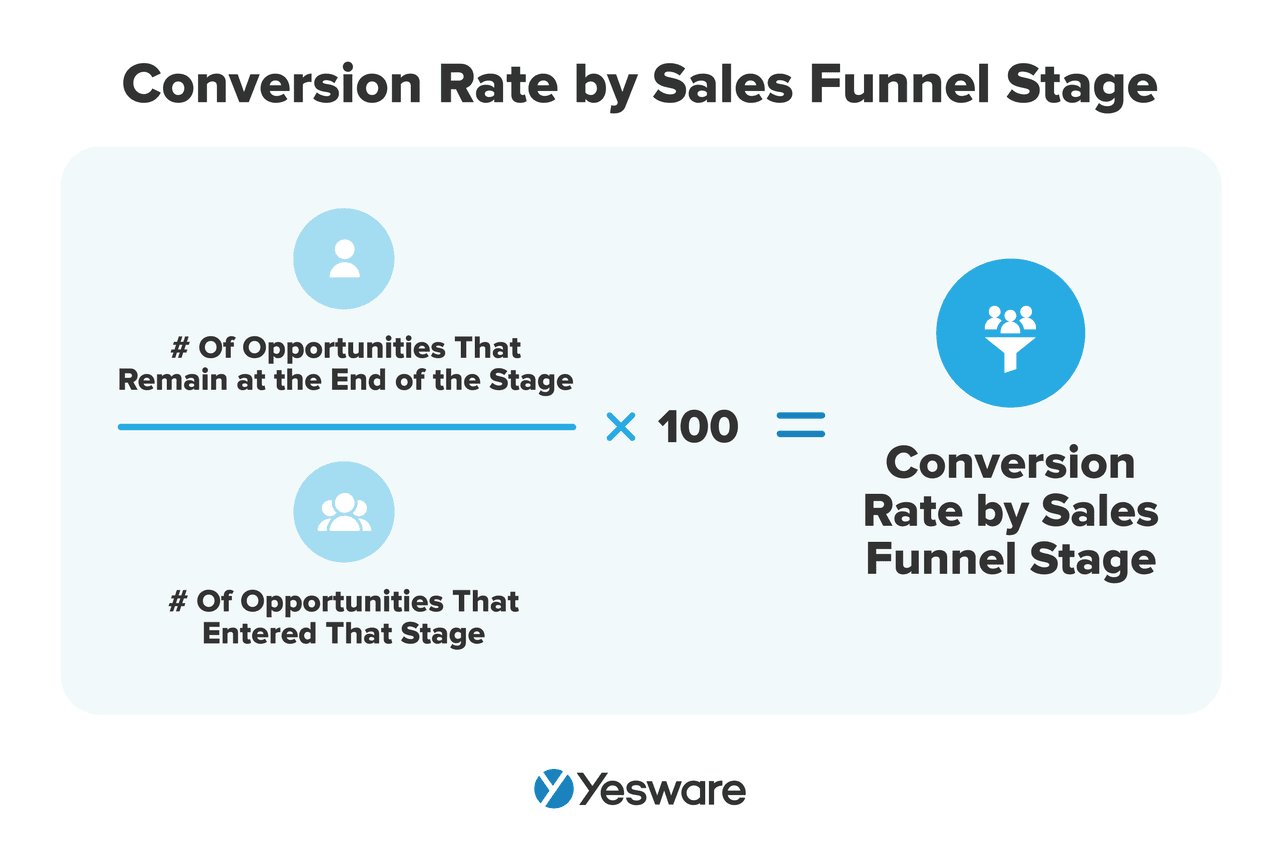 Tip: We measured various of the metrics discussed in this article with over three million sales activities to create a data trends guide. Check it out below.
Tip: We measured various of the metrics discussed in this article with over three million sales activities to create a data trends guide. Check it out below.
 Sales Engagement Data Trends from 3+ Million Sales ActivitiesLooking at millions of tracked email activity over the past few years, this ebook is filled with our top studies and findings to help sales teams accelerate results.
Sales Engagement Data Trends from 3+ Million Sales ActivitiesLooking at millions of tracked email activity over the past few years, this ebook is filled with our top studies and findings to help sales teams accelerate results.
13. Overall Conversion Rate
Your team’s overall conversion rate represents how many deals your team collectively closes relative to how many visitors you started with at the beginning of the sales period.
Here’s the formula to calculate conversion rate:  Let’s look at this in terms of a basic example.
Let’s look at this in terms of a basic example.
Let’s say your team generates 1,000 leads at the beginning of a given sales period.
At the end of that sales period, the reps on your team have closed 104 deals.
First, divide the number of closed deals (104) by the number of leads at the start of the period (1,000).
Then, multiply by 100 to find the conversion rate.
(104/1,000) x 100 = 10.4%
Conversion rate is one of the most important metrics for sales and marketing to measure, as it helps them track the effectiveness and overall performance of their campaigns.
14. Customer Acquisition Cost (CAC)
The customer acquisition cost (CAC) metric tells sales teams how much they spend, on average, to acquire each customer.
Here’s the formula to calculate CAC: 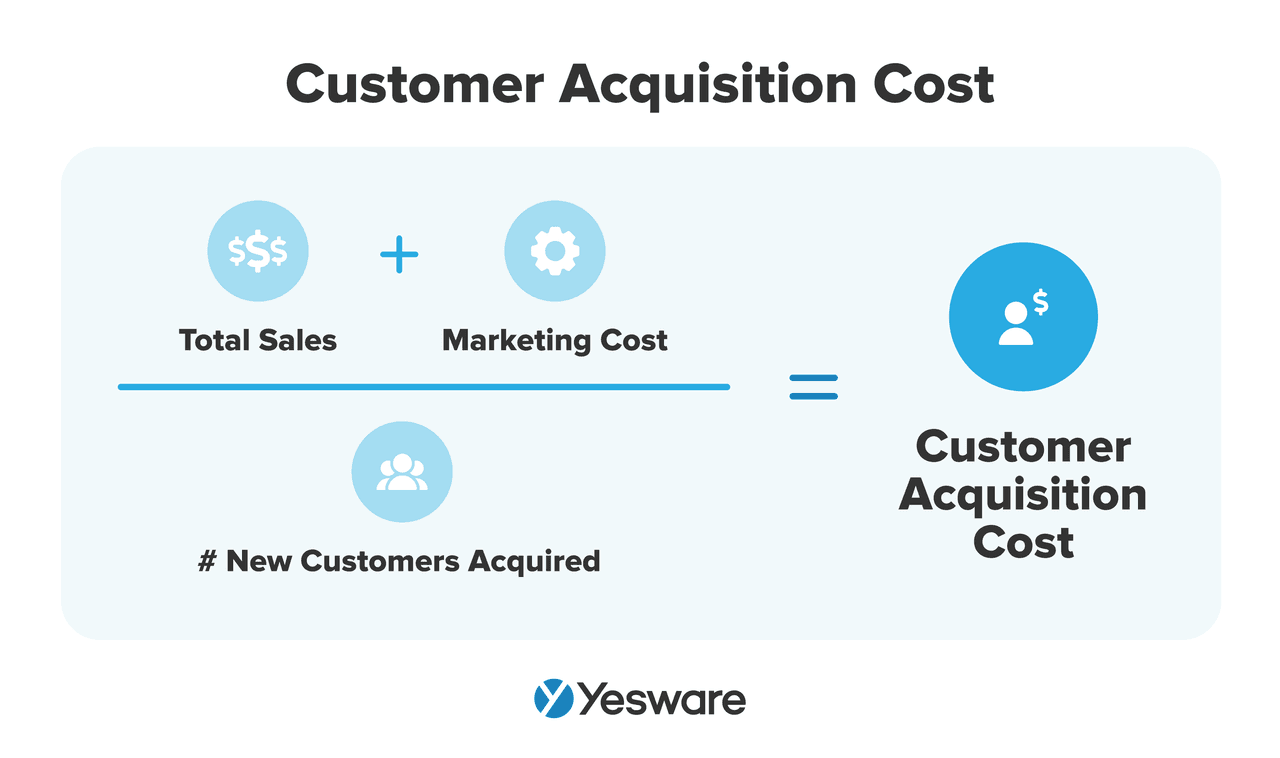 Customer acquisition cost helps sales teams evaluate the profitability of their customers, and the overall ROI of their marketing efforts.
Customer acquisition cost helps sales teams evaluate the profitability of their customers, and the overall ROI of their marketing efforts.
It’s important to note that, in general, if the CAC exceeds the customer lifetime value (CLV), your team will lose money in the long run.
15. Average Deal Size
Average deal size is relatively straightforward — it’s the average value of each deal generated from your pipeline.
Here’s the formula to calculate average deal size: 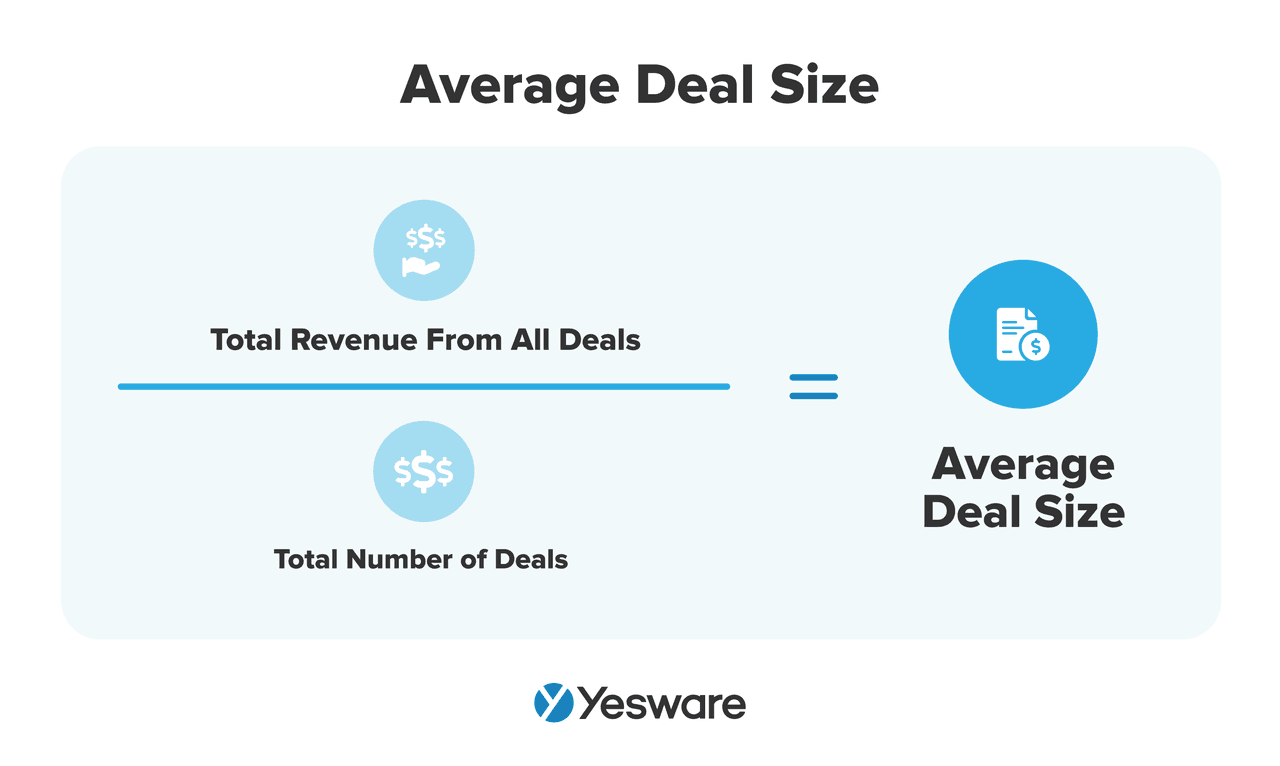 Average deal size helps sales teams evaluate their current performance, but it’s also a key sales metric for sales forecasting.
Average deal size helps sales teams evaluate their current performance, but it’s also a key sales metric for sales forecasting.
The higher the average deal size, the more likely it is that your team is closing higher-value deals; this can lead to higher confidence in aggressive sales forecasts.
16. Average Profit Margin
Calculating average profit margin helps sales teams understand how much total revenue their organization actually pockets after accounting for expenses.
There are several ways to calculate profit margin, the three most common being gross profit margin, operating profit margin, and net profit margin.
Here are the formulas to calculate each: 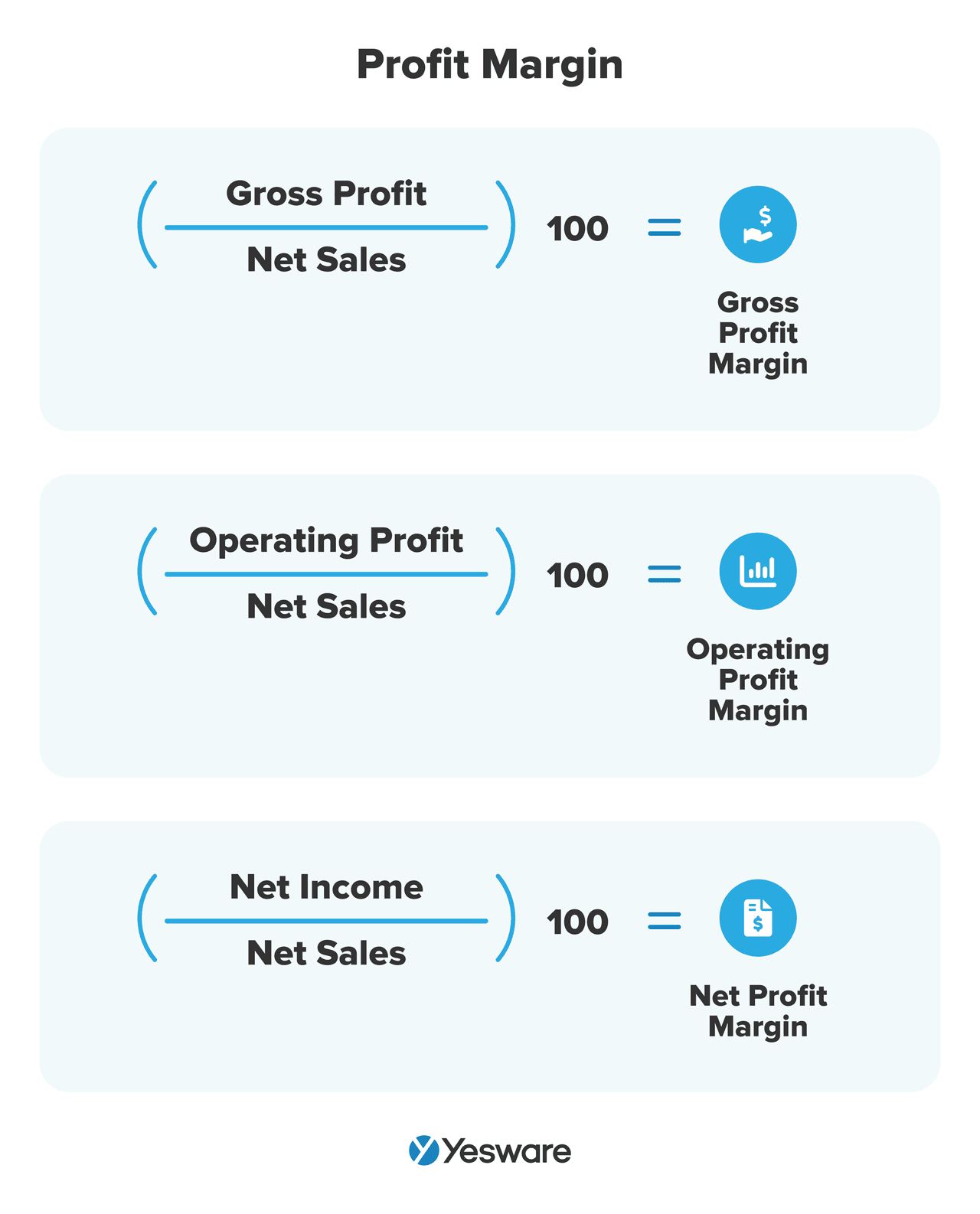 Gross profit represents the amount of money a business keeps after deducting the costs of manufacturing the product, or the cost of goods sold (COGS).
Gross profit represents the amount of money a business keeps after deducting the costs of manufacturing the product, or the cost of goods sold (COGS).
Operating profit margin is gross profit, minus operational costs.
Net profit is the final profit calculation in the chain — the amount of money a business counts as profit after deducting COGS, operational costs, and all other deductions (e.g., interest and taxes).
17. Churn Rate
Churn rate is the percentage of customers that decide to break or not renew their contracts after a specific time period.
Here’s the formula to calculate churn rate: 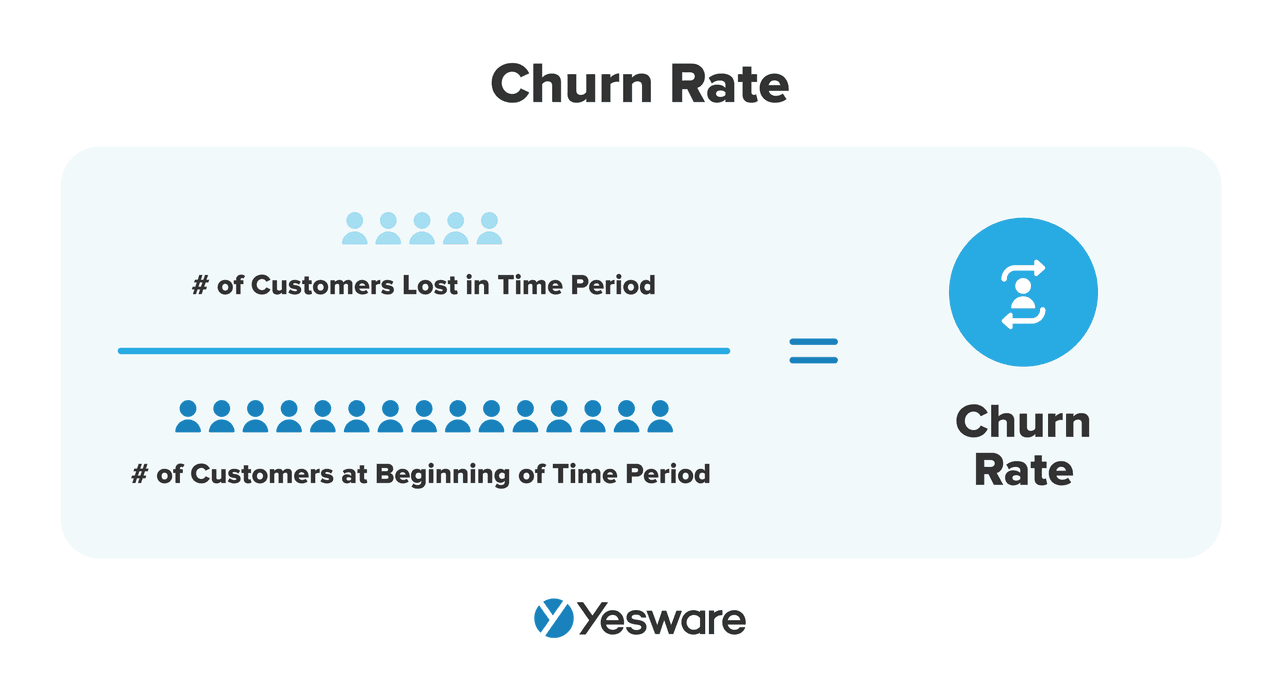 The higher your churn rate, the more of a hit your team will take on revenue.
The higher your churn rate, the more of a hit your team will take on revenue.
What’s more, research shows that it costs anywhere from 5x – 25x as much money to acquire a new customer as it does to retain an existing one. That means that every customer that churns costs a significant amount to replace.
18. Net Promoter Score (NPS)
The net promoter score (NPS) is a general measure of how loyal your customer base is to your brand.
The NPS is based on a customer survey that asks how likely a customer would be to recommend the brand to someone else.
To calculate your brand’s NPS, your team first needs to distribute a customer survey asking how likely each of your clients would be to recommend your product or service to a friend. Most companies give customers the option to respond on a scale of 1 – 10.
The 1-10 scale is broken into three categories:
- Promoters: Customers who respond with a 9 or a 10. These are your most loyal and enthusiastic customers.
- Passives: Customers who responded with a 7 or 8. These customers are satisfied but not actively recommending your brand.
- Detractors: Customers who respond anywhere from 0 – 6. These customers are unhappy and may cause damage to your brand by sharing negative experiences.
To determine the sales metric, subtract the percentage of Detractors from the percentage of Promoters. This is your NPS.
Here’s the formula to calculate NPS: 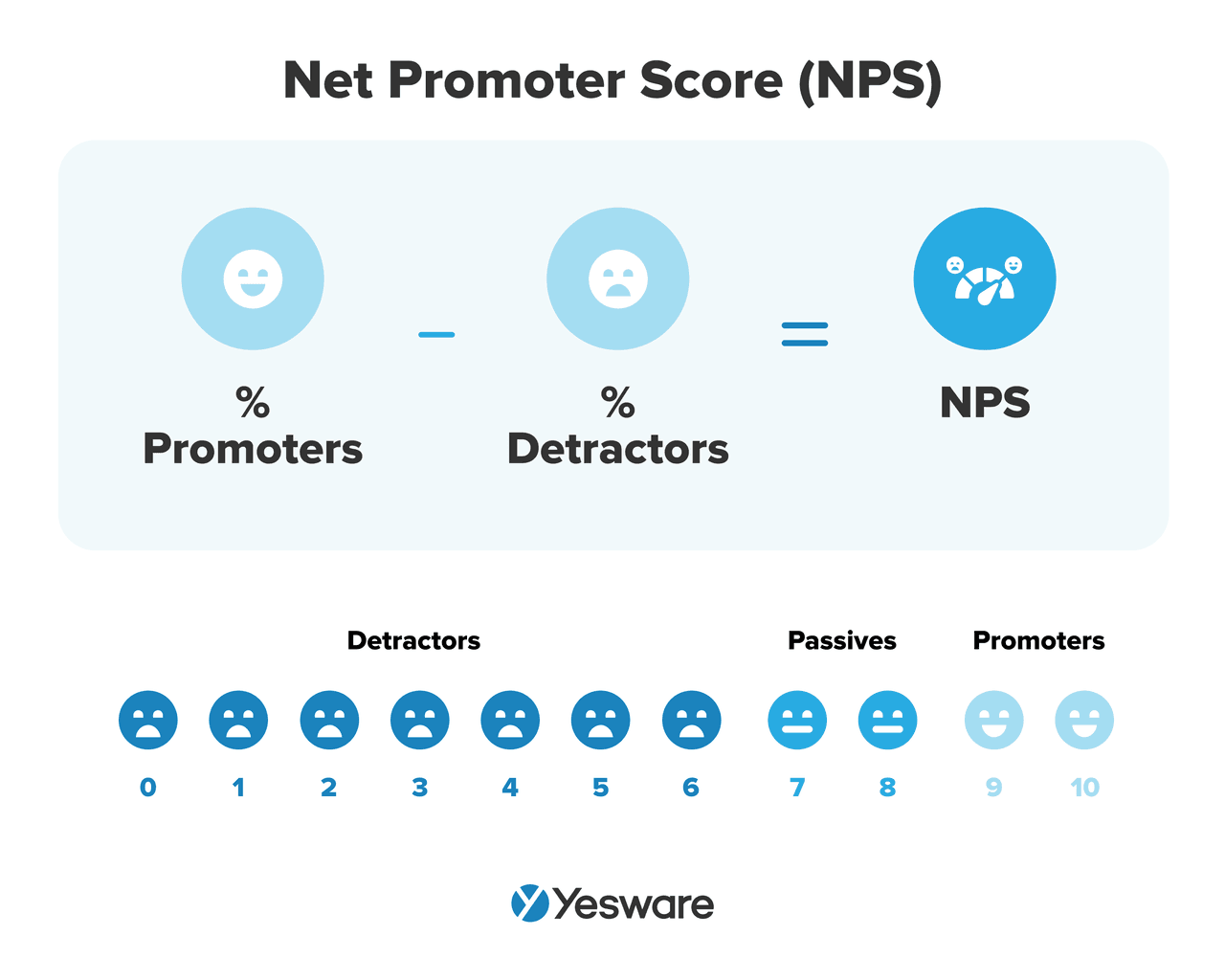 The importance of Promoters (also sometimes called brand ambassadors) cannot be understated in today’s hyper-social sales world — referred customers are like gold for B2B organizations.
The importance of Promoters (also sometimes called brand ambassadors) cannot be understated in today’s hyper-social sales world — referred customers are like gold for B2B organizations.
Many companies overlook the simple step of distributing a one-question customer survey, and would be well-served by the data their NPS provides. If you don’t know your organization’s NPS, send out a survey ASAP to get the process going.
19. Net Revenue Retention Percentage
Net revenue retention percentage (NRR) is an important metric for SaaS businesses, and represents the percentage of revenue retained from customers over a certain period of time (typically monthly or yearly). NRR accounts for upgrades, downgrades, cross-sells, and cancellations.
To calculate NRR, take your total revenue and subtract your revenue churn.
This formula can be complex, though, and requires some data-digging.
Here’s the NRR formula expressed in further detail: 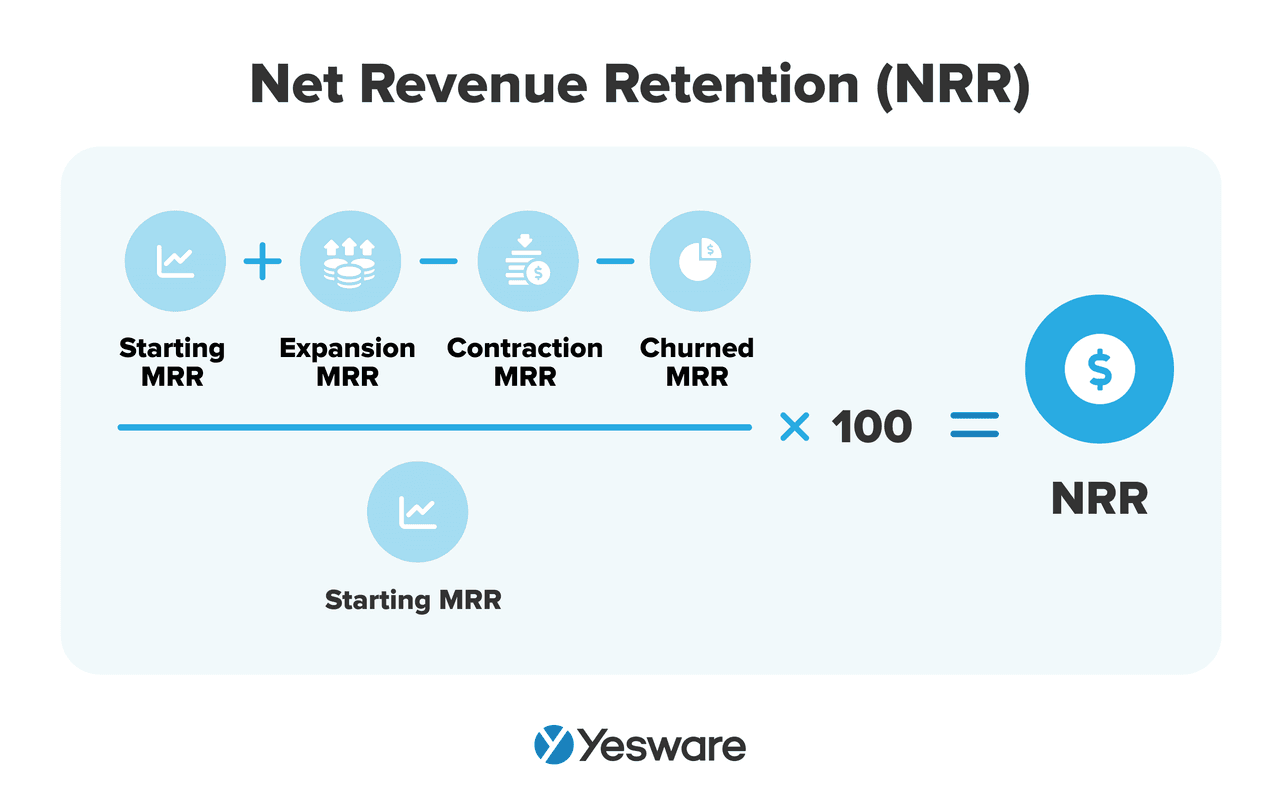 NRR is a very important growth metric. It gives very comprehensive oversight into your offer’s churn, retention, adoption, and expansion rates.
NRR is a very important growth metric. It gives very comprehensive oversight into your offer’s churn, retention, adoption, and expansion rates.
In other words, it gives your team a very good sense of your offer’s momentum in the overall market.
20. Weighted Value of Pipeline
A weighted pipeline is one that prioritizes each opportunity according to how likely each one is to close.
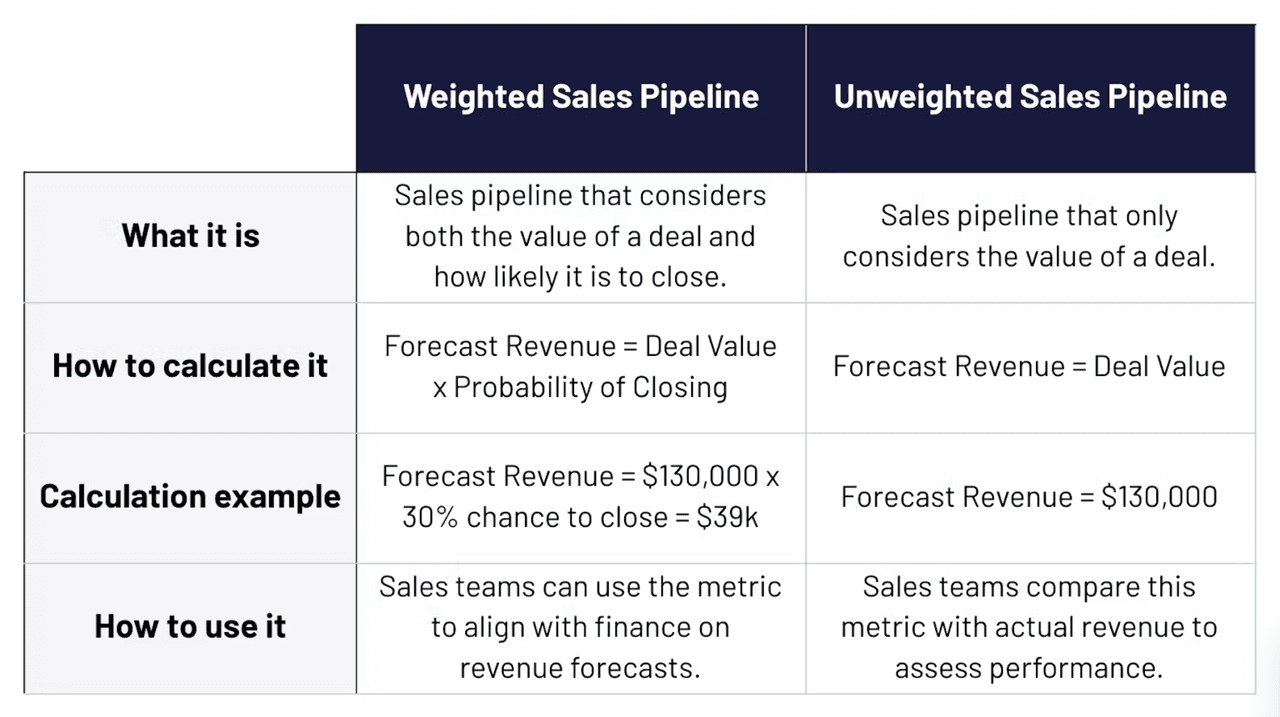
It can take some trial and error to learn how to calculate your team’s weighted pipeline, but the results are worth it when you get it in the right range. Accurate weighted sales pipelines improve sales forecasting, close rates, and revenue growth.
To calculate a weighted sales pipeline, sales and marketing need to collaborate to assign each deal a probability of closing based on their stage in the sales funnel and their buying signals.
Once you determine the probability of each deal, multiply by the value to determine the weight in the pipeline.
21. Lead Response Time
Lead response time is one of the most important metrics for B2B sales teams, whether they work with inbound or outbound leads.
The sooner you can respond to a lead’s interest, the better. Responding within the “Golden Window” greatly improves a rep’s chances of converting a lead.
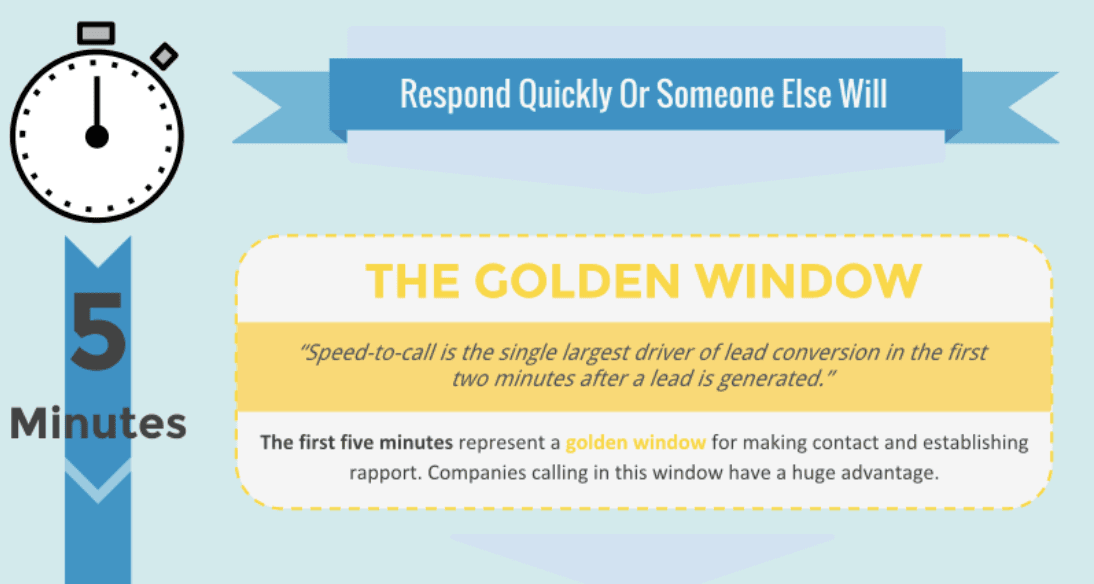
The way your team calculates lead response time will vary based on the ways in which you generate leads, and the ways in which you choose to respond.
Here’s the formula to calculate lead response time: 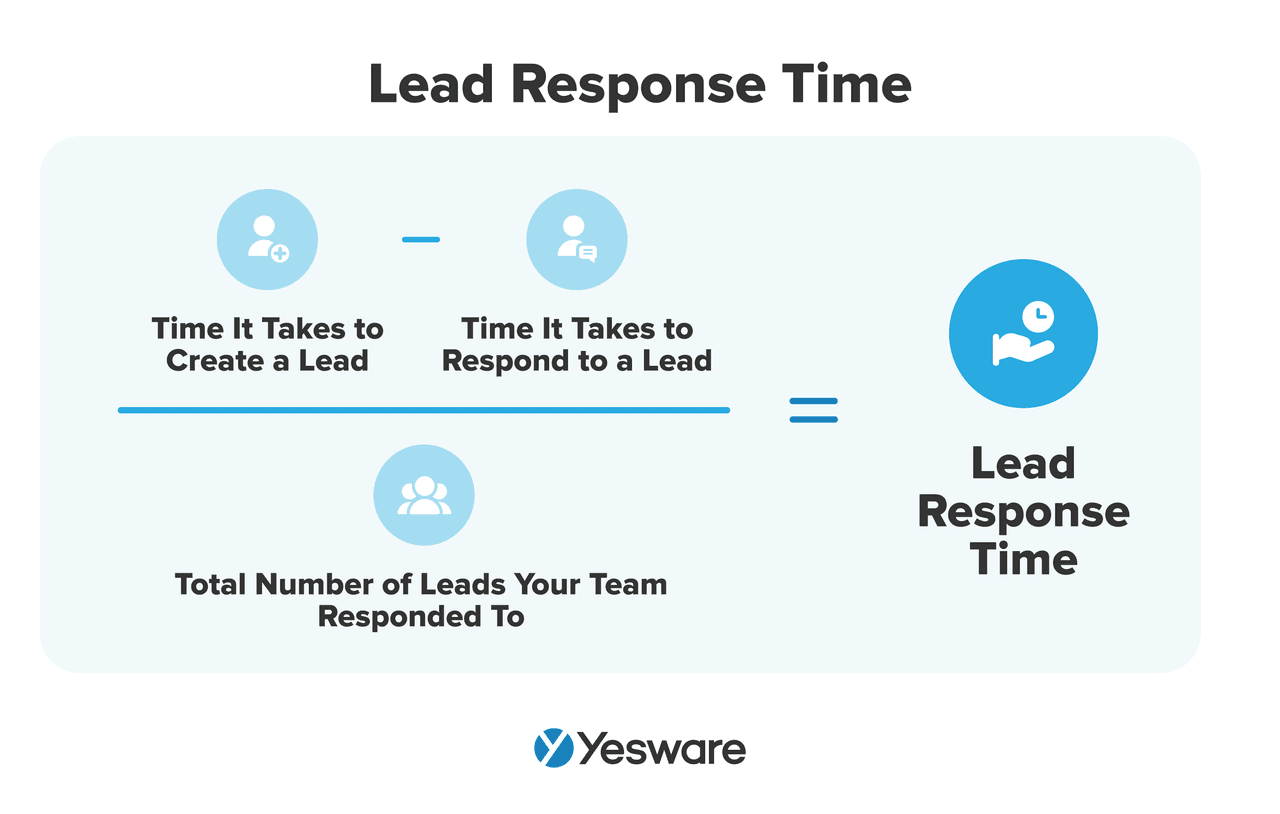
22. Email Open Rate
Email open rate is the percentage of email subscribers that open a given email, versus the total number of subscribers who received the email.
Here’s the formula to calculate email open rate: 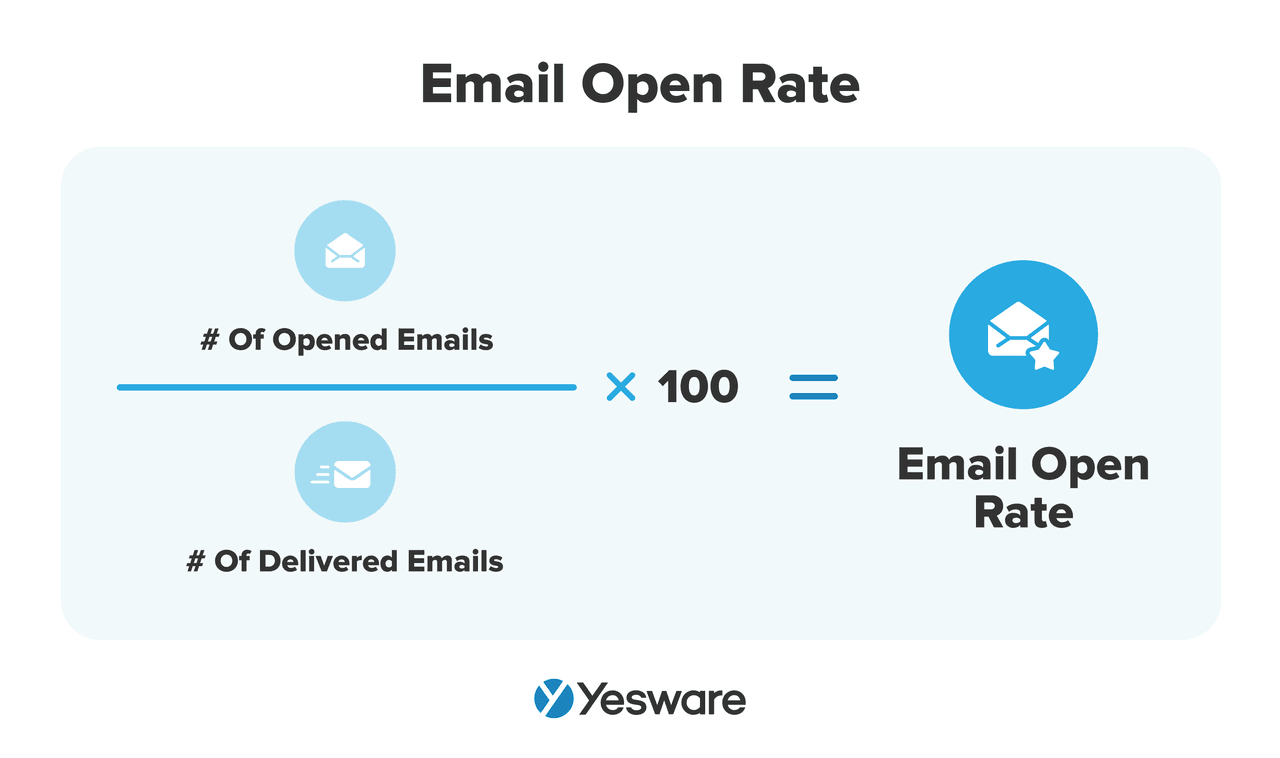 Email open rate is one of the most important sales metrics for email engagement (more on this sales metric in a minute). It helps sales and marketing teams get insight into the overall effectiveness of their email marketing campaigns.
Email open rate is one of the most important sales metrics for email engagement (more on this sales metric in a minute). It helps sales and marketing teams get insight into the overall effectiveness of their email marketing campaigns.
23. Email Response Rate
Email response rate calculates the number of direct replies your reps receive as a result of your email marketing campaigns.
Here’s the formula to calculate email response rate: 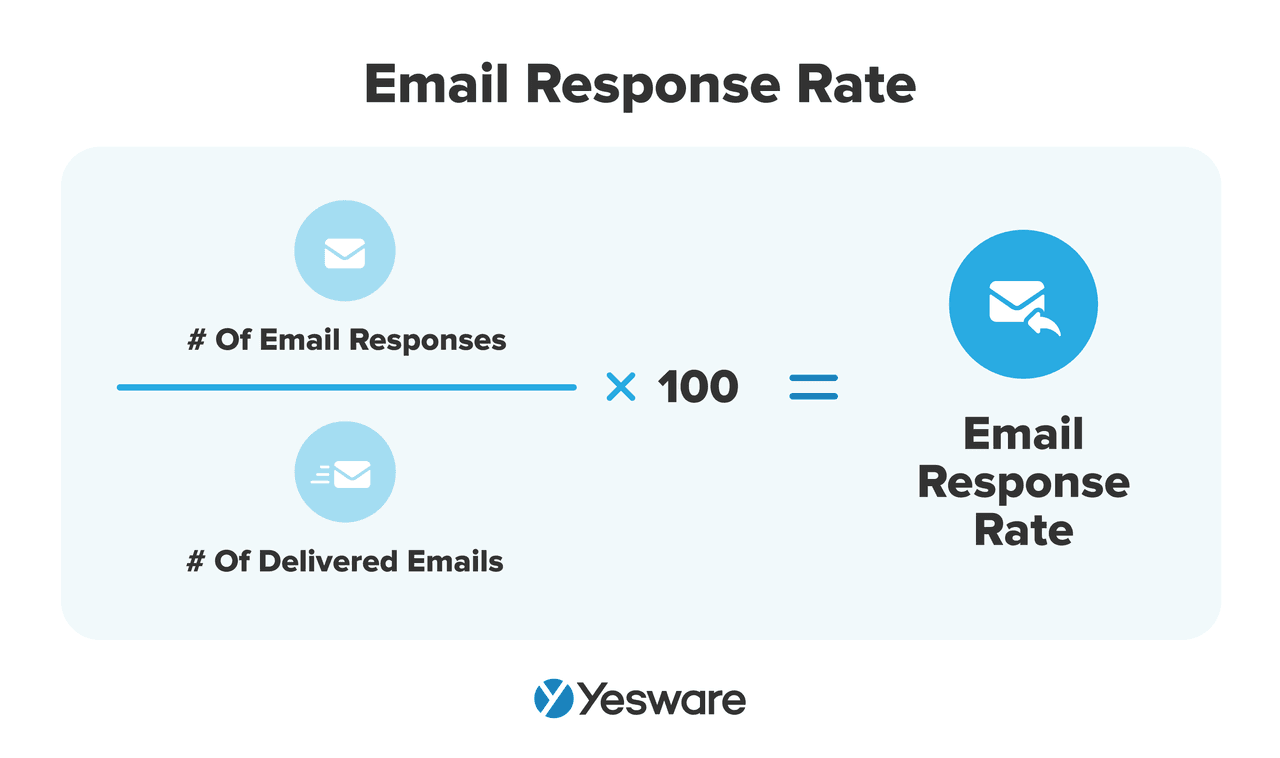 Average email response rate varies by industry, segment list, and more; pay attention to the market trends and (more importantly) buyer persona preferences that are most likely to affect your individual email campaigns.
Average email response rate varies by industry, segment list, and more; pay attention to the market trends and (more importantly) buyer persona preferences that are most likely to affect your individual email campaigns.
24. Email Engagement Rate
Your team’s email engagement rate helps give insight into the effectiveness of your email marketing strategy.
Email engagement rate may take into account any combination of the following:
- Email open rate
- Amount of time spent reading emails
- Attachment open rate
- Click-through rate
- Click-to-open rate
- Unsubscribe rate
Tools can be a great hand in generating these numbers for you.
Yesware helps sales teams quantify their email engagement rate, which can otherwise be hard to measure. With sophisticated reporting and analytics tools, your team can determine reply rate, email engagement rate, link clicks, and more.
25. Sales Linearity
Sales linearity is a measure of how predictably your team’s sales opportunities close on a week-to-week, month-to-month, or quarter-to-quarter basis.
Calculating sales linearity can be quite complex, but at its core, it’s all about determining a metric for the regularity of closing deals.
Remember, these are only a small fraction of the sales metrics that a team or organization can track. It’s up to your organization to determine which metrics and sales KPIs matter most to their goals.
Remember, too, that as your business grows, your most important sales metrics are likely to change. It’s important to create and revisit your sales goals frequently to determine what sales metrics move the needle most at a given time.
Sales Activity Metrics
As important as it is to track sales metrics that speak to your team’s output — that is, their measurable results — it’s also vital that sales teams track their own activity.
Tracking sales activity helps sales teams determine how much of their time gets dedicated to effective sales activities. It sheds light on which activities or processes make the biggest difference throughout the sales process.
Sales teams who want to improve their sales efficiency and effectiveness should consider tracking some or all of the following sales activity/sales productivity metrics:
- Percentage of time on manual data entry
- Calls made
- Emails sent
- Time spent creating content
- Number of sales conversations
- Number of sales tools used on a daily basis
- The number of social media engagements
- Number of scheduled meetings
- Number of demos or presentations
- Referrals
All of these metrics will help salespeople take a more careful look at how they spend their time.
The stark reality is that most salespeople spend only about a third of their time on revenue-generating sales activities.

Sales software like Yesware can help salespeople carefully scrutinize how their efforts are distributed, and which activities generate the most results.
Leading vs Lagging Indicators
As you may have been wondering, not all sales metrics are created equal. That’s not to say that they’re not all beneficial — but some sales metrics (like revenue-based ones) indicate a final result, while others measure input into the sales process (like number of calls made).
The difference between these two kinds of metrics is described as leading vs. lagging indicators.

Lagging indicators are ones that indicate your results. They are easier to measure, but difficult to influence once they are determined.
In other words, lagging indicators show you in hindsight how effectively your planning and execution addressed your goals.
Leading indicators, on the other hand, are ones that predict your results. They are factors that you can measure proactively — and influence accordingly — that dictate your ultimate results.
Sales activity metrics are good examples of leading indicators.
Both leading and lagging indicators are important pieces of the puzzle in measuring sales metrics.
Challenges in Tracking Sales Metrics
One of the biggest challenges in effectively tracking sales metrics is the sheer volume of the available data.
Many sales software tools make easy work of collecting and storing data, but those are the easy parts. More data does not necessarily equal better data; too many companies miss this point entirely.
The real challenge lies in figuring out how to leverage sales data in a way that improves performance.
Fortunately, there are some sales software platforms that help salespeople use data in a way that drives their success.
Sales Tracking Tools
If you’re serious about tracking sales metrics for analytics purposes, there are a few kinds of software that will go a long way in helping your team wrap their heads around the process.
CRM
First and foremost, you’ll need a well-adopted CRM. Most sales organizations pay for one, but many do not use them nearly effectively enough.
Leverage the capabilities of your CRM to automate as much data collection and management as you can, and ensure that everyone on your team is trained — and expected to participate — in standardized data management processes.
Sales Productivity Tracker
Many CRM systems help salespeople track their daily activities. If yours doesn’t, it’s worth it to invest in a platform that does.
These programs will give your team a good beat on the leading indicators that indicate performance results.
Buyer Activity Tracker
Sales engagement software is an underutilized resource in tracking sales metrics, but it proves to be a game-changer for teams who want to make data-informed decisions.
Yesware helps salespeople track how and when their emails are opened, how heavily leads and prospects engage with their content, and the best opportunities for following up to close deals.
With robust reporting & analytics capabilities, along with our ability to connect directly to your CRM, Yesware also helps users look at both leading and lagging indicators alongside one another to help optimize the pipeline.

You can then make data-informed decisions by always being in the know of what messaging is working and what’s not.
![]()
Does your team track sales metrics? What is your process like? How can you streamline it for better results?
Get sales tips and strategies delivered straight to your inbox.
Yesware will help you generate more sales right from your inbox. Try our Outlook add-on or Gmail Chrome extension for free, forever!
Related Articles
Anya Vitko
Anya Vitko
Anya Vitko
Sales, deal management, and communication tips for your inbox

